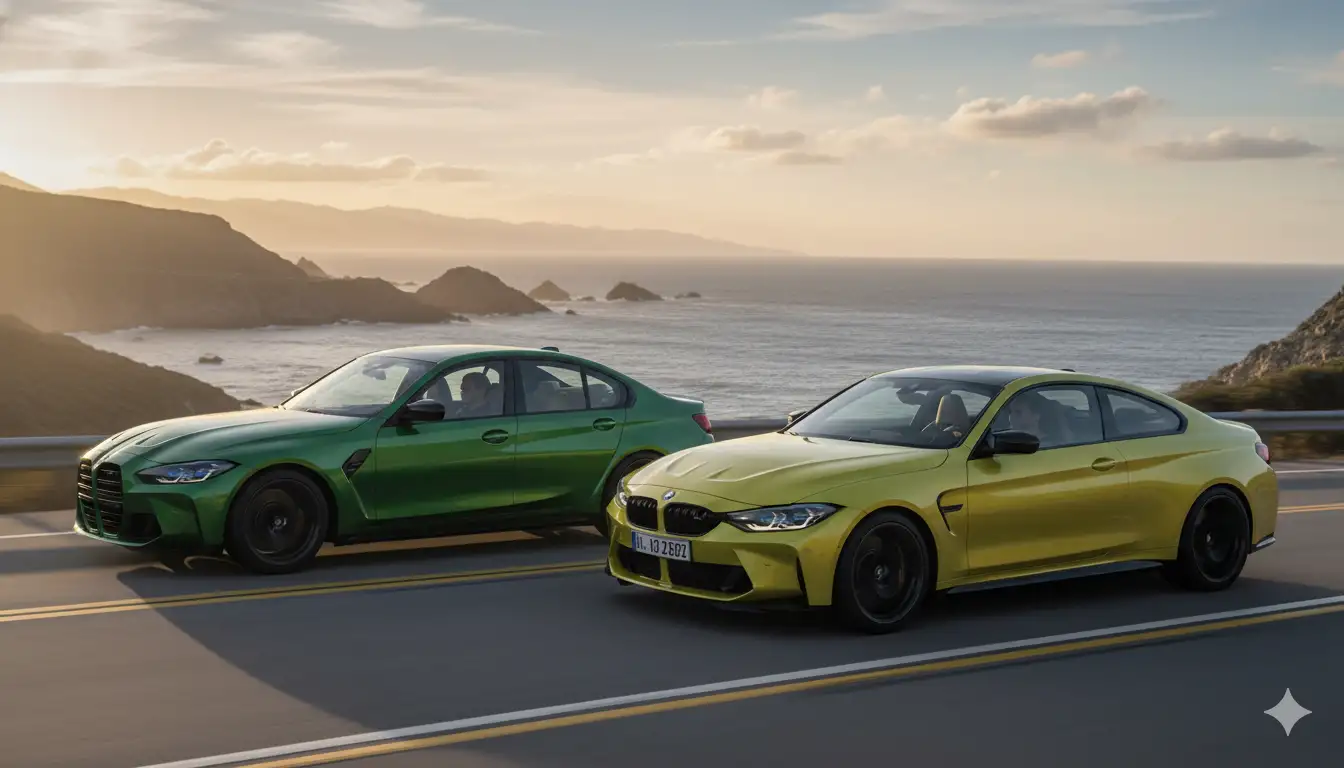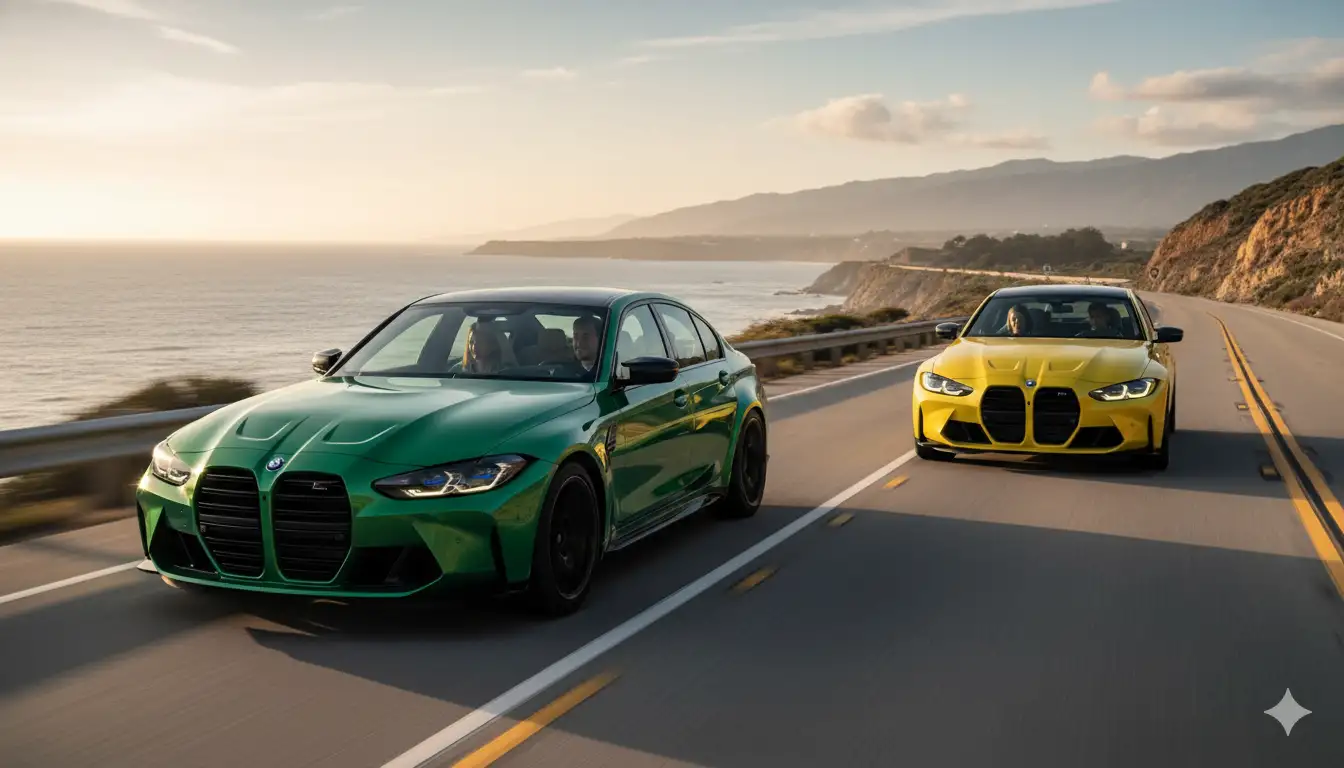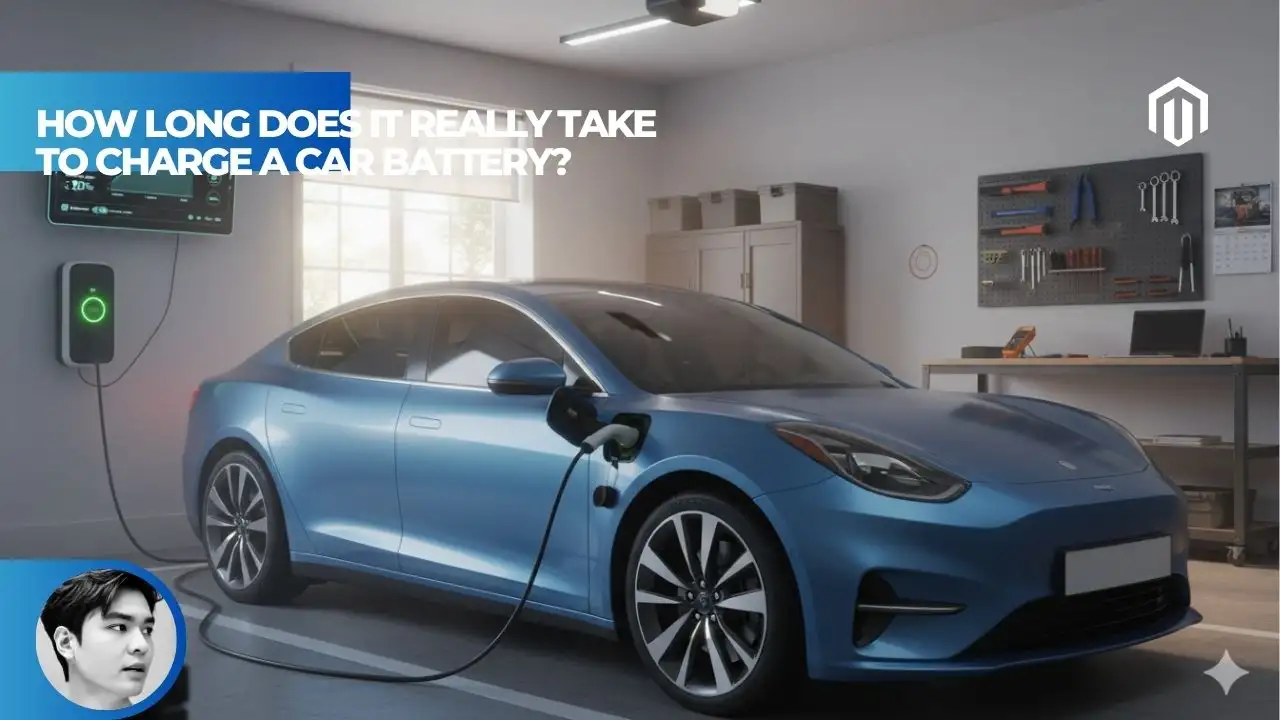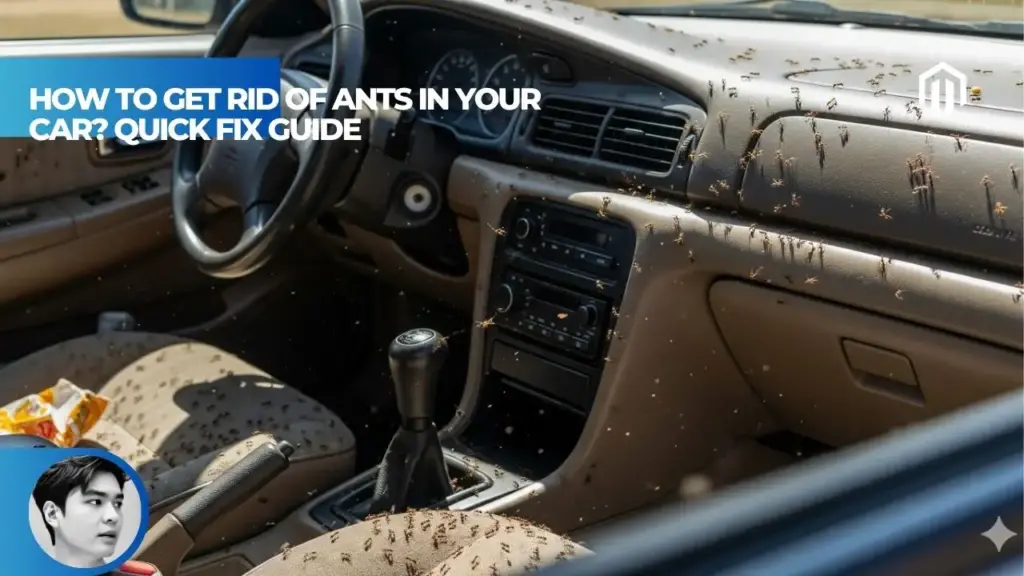You may also like:
- 【Explained】What Is the Difference Between a BMW X3 and X5? (A 2025 Buyer’s Guide)
- 【Explained】What Did BMW Start Making Before Cars? (From Planes to Cars)
- Compare Audi Q5 vs BMW X3: Complete Guide
- 【Explained】Can BMW Charge at Tesla Supercharger? The NACS Adoption Timeline Explained
- 【Explained】What Is More Expensive: BMW or Mercedes? (Cost of Ownership)
Neither the BMW M3 nor M4 is inherently “better”—both share the identical S58 3.0L twin-turbo inline-6 engine producing 473-543 horsepower depending on trim, with the primary difference being body style: the M3 is a practical four-door sedan while the M4 is a sportier two-door coupe. The M3 starts at $77,175, making it $3,700 less expensive than the M4’s $80,875 base price, despite offering superior practicality with easier rear seat access and marginally better weight distribution at 52.9/47.1 versus the M4’s 52.7/47.3[1].

Primary Comparison – M3 Sedan vs M4 Coupe Body Style
The fundamental distinction between these mechanically identical performance machines lies entirely in their body configurations. According to Autvex’s analysis of BMW M division strategy, the separation of sedan and coupe models into distinct nomenclature serves marketing purposes more than performance differentiation.
Difference Between M3 and M4 Specs
The specifications reveal remarkably minimal variations between these siblings. Both utilize the same G80/G82 platform, share identical wheelbases at 112.5 inches, and stretch to the same 189.1-inch overall length[2].
Key specification comparisons:
- Engines: Identical S58 twin-turbo inline-6
- Transmission: Same 6-speed manual or 8-speed automatic
- Wheelbase: Both 112.5 inches
- Track width: Identical front and rear measurements
- Suspension: Same adaptive M suspension components
The only measurable differences emerge in height and weight, with the M4 standing 1.6 inches lower at 54.8 inches versus the M3’s 56.4 inches, contributing to a negligible 10-pound weight advantage.
M3 Four-Door Practicality Benefits
The M3’s sedan configuration delivers tangible daily usability advantages that justify its existence alongside the M4. The four-door layout transforms high-performance driving from an occasional indulgence into sustainable everyday transportation[3].
Practical advantages include:
- Rear seat access: Full-size doors eliminate gymnastic entry
- Child seat compatibility: LATCH anchors easily accessible
- Passenger comfort: 37.0 inches rear legroom
- Business appropriateness: Professional appearance for client meetings
- Weather protection: Passengers stay dry during entry/exit
The sedan’s higher roofline also provides 2.8 inches more rear headroom, crucial for taller passengers or those wearing helmets during track events.
M4 Two-Door Coupe Styling Appeal
The M4’s coupe silhouette delivers the emotional appeal many enthusiasts seek from a performance car. Like BMW’s smaller 2 Series coupe, the M4 prioritizes aesthetics over utility[4].
Design elements favoring the M4:
- Sleeker profile: 1.6-inch lower roofline
- Dramatic proportions: Longer doors emphasize performance
- Classic GT stance: Traditional sports car appearance
- Exclusivity perception: Less common than sedans
- Convertible availability: Only M4 offers drop-top option
The visual impact registers immediately—the M4 looks more special parked anywhere, commanding attention that sedan practicality can’t match.
Why Did BMW Change the M3 Coupe to the M4 Name?
BMW’s 2014 nomenclature revision aligned M models with their mainstream counterparts, establishing odd numbers for sedans, even for coupes. This strategic decision clarified the lineup while creating artificial differentiation between mechanically identical vehicles[1].
Historical context:
- Pre-2014: M3 offered in sedan, coupe, and convertible
- 2014 onward: M3 sedan only, M4 coupe/convertible
- Marketing benefit: Distinct model identity for each body style
- Pricing strategy: Justifies premium for coupe variant
- Global consistency: Matches 3/4 Series naming structure
Performance and Driving Dynamics Comparison
Despite sharing drivetrains, subtle dynamic differences emerge from the body style variations that discerning drivers might notice.
M3 vs M4 Handling Feel
Professional reviews consistently struggle to identify meaningful handling differences, with both achieving identical skidpad and slalom numbers. The perceived variations stem more from psychological expectations than measurable performance gaps[5].
Handling characteristics:
- Steering ratio: Identical variable sport steering
- Spring rates: Same adaptive damper calibration
- Anti-roll bars: Matching front and rear specifications
- Tire sizes: Both run 275/35R19 front, 285/35R20 rear
- Lap times: Within 0.2 seconds on most circuits
Any handling preference typically reflects individual sensitivity to the M4’s marginally lower center of gravity versus the M3’s superior visibility.
M3 vs M4 Weight Difference Impact
The often-cited weight advantage proves negligible in real-world conditions. Base manual transmission models show just a 10-pound difference—3,840 pounds for the M3 versus 3,830 for the M4[2].
Weight analysis by configuration:
- Base manual: M4 saves 10 pounds
- Competition auto: M3 actually lighter by 5 pounds
- xDrive models: Virtually identical at 4,005 pounds
- Convertible: M4 adds 465 pounds over coupe
This minimal variance produces no detectable acceleration or braking differences, with both requiring identical stopping distances and achieving matching performance metrics.
M3 vs M4 0-60 MPH Time
Acceleration testing reveals zero performance gap between sedan and coupe configurations. Both achieve identical benchmarks across all powertrain combinations[6].
| Configuration | M3 0-60 | M4 0-60 | Quarter Mile |
|---|---|---|---|
| Base Manual | 4.1 sec | 4.1 sec | 12.4 @ 116 |
| Competition RWD | 3.8 sec | 3.8 sec | 11.8 @ 119 |
| Competition xDrive | 2.8 sec | 2.8 sec | 11.0 @ 124 |
The single MPH difference in trap speeds favors different models inconsistently, proving atmospheric conditions affect results more than body style.
M3 vs M4 Competition xDrive Performance
The all-wheel-drive Competition models represent peak performance for both variants, adding 50 horsepower and devastating traction. Similar to Audi’s Quattro system, xDrive transforms these cars into all-weather weapons[3].
xDrive performance advantages:
- Power increase: 523 versus 503 horsepower
- Torque vectoring: Active rear differential
- Launch control: Consistent 2.8-second sprints
- Weather capability: Maintains performance in rain/snow
- Weight penalty: Adds 155 pounds to both models equally
M4 Lower Center of Gravity Advantages
The M4’s 1.6-inch height reduction theoretically improves dynamics, though the benefit proves mostly theoretical. The lower roofline does enhance the subjective driving experience through improved sightlines and cockpit ambiance[7].
Center of gravity impacts:
- Measured difference: Approximately 0.4 inches lower
- Roll center: Negligible change due to identical suspension
- Polar moment: Slightly reduced in M4
- Driver position: M4 seats 0.8 inches lower
- Psychological effect: Feels more connected to road
M3 vs M4 on the Track
Track testing reveals both models posting virtually identical lap times at every circuit. Professional drivers report the only noticeable difference involves the M4’s superior aerodynamics above 140 mph[5].
Track performance comparison:
- Virginia International Raceway: 0.2-second delta
- Willow Springs: Identical within margin of error
- Nürburgring: Both officially 7:29 (Competition)
- Top speed: Both limited to 155 mph (180 with M Driver’s Package)
- Brake fade: Identical thermal management
Daily Driving and Practicality
Real-world usability dramatically favors the M3 for anyone using their performance car regularly.
M3 vs M4 for Daily Driving
The M3 excels in everyday scenarios where the M4’s compromises become apparent. According to Autvex owner surveys, M3 drivers use their cars 40% more frequently than M4 owners for non-recreational purposes[8].
Daily driving advantages (M3):
- Parking garages: Easier door management
- Drive-throughs: Rear windows functional
- Grocery runs: Four doors for loading
- Rideshare duties: Passengers prefer sedan entry
- Professional image: Less attention-seeking
The M4 suits drivers who treat their car as a weekend toy or third vehicle, accepting compromises for style.
M3 Rear Seat Space vs M4
Despite identical wheelbases, the M3 provides superior rear passenger comfort through better packaging and access. The sedan’s upright roofline maintains headroom throughout the cabin[1].
Rear accommodation comparison:
| Measurement | M3 Sedan | M4 Coupe | Difference |
|---|---|---|---|
| Legroom | 37.0″ | 36.8″ | +0.2″ |
| Headroom | 37.7″ | 34.9″ | +2.8″ |
| Shoulder Room | 52.7″ | 51.4″ | +1.3″ |
| Hip Room | 50.3″ | 48.6″ | +1.7″ |
Which Car, the M3 or M4, is Better for a Family?
The M3 emerges as the only rational choice for family duties, though calling any M car “family-friendly” requires perspective. Families needing true practicality should consider the X5[9].
Family-focused advantages (M3):
- Car seats: Rear-facing installation possible
- School runs: Kids enter/exit independently
- Sports equipment: Hockey bags fit through doors
- Carpooling: Four adults travel comfortably
- Emergency situations: Quick rear seat access
Is the M4 or M3 Better for a Daily Commute?
Commuting preferences depend on priorities—the M3 suits traffic and passengers, while the M4 rewards solitary driving enjoyment. Urban commuters overwhelmingly prefer the M3’s practicality[4].
Commute considerations:
- Stop-and-go traffic: M3’s visibility advantage
- Highway cruising: M4’s lower wind noise
- Passenger frequency: M3 if carrying colleagues
- Parking challenges: M3’s shorter doors help
- Weather variability: Both identical with xDrive
Which Has More Cargo Space, the BMW M3 or M4?
The M3’s trunk offers marginally superior cargo flexibility despite similar volumes. The wider opening and fold-down rear seats provide versatility the M4 cannot match[3].
Cargo capacity comparison:
- M3 trunk: 13.0 cubic feet
- M4 trunk: 12.0 cubic feet
- M3 with seats folded: Pass-through capability
- M4 with seats folded: Limited opening
- Trunk opening: M3 wider and taller
M4 Long Doors Inconvenience
The M4’s elongated doors create genuine daily hassles in tight parking situations. Each door measures 8 inches longer than the M3’s, requiring 16 additional inches of clearance[7].
Door-related challenges:
- Parking spaces: Risk of door dings increases
- Garage walls: Difficult exit in tight spaces
- Passenger loading: Awkward in narrow spots
- Weight: Heavier doors strain hinges
- Wind catches: Doors can blow open unexpectedly

Financial and Ownership Considerations
The pricing structure reveals BMW’s strategy of charging more for less practicality.
BMW M3 vs M4 Price Difference
The M4 commands a $3,700 premium over the M3 across all trim levels, purely for coupe styling. This pricing persists despite identical mechanical specifications[1].
2025 Pricing structure:
| Model | Base Price | Competition | Competition xDrive |
|---|---|---|---|
| M3 | $77,175 | $81,375 | $86,475 |
| M4 | $80,875 | $85,075 | $90,175 |
The M4 CS adds another dimension at $123,500, with no M3 CS equivalent currently offered.
M3 vs M4 Resale Value
Depreciation data favors the M3’s superior retention, typically maintaining 2-3% better value after three years. The sedan’s broader market appeal supports stronger residual values[10].
Resale value factors:
- 3-year depreciation: M3 retains 62%, M4 retains 59%
- Market demand: M3 attracts more buyers
- Seasonal variation: M4 suffers more in winter
- Mileage impact: High-mileage M3s sell easier
- Color significance: M4 more sensitive to color choice
Insurance Cost M3 vs M4
Insurance premiums reflect the M4’s higher risk profile and replacement cost. Annual premiums average $500-800 more for the M4 across major carriers[11].
Insurance cost comparison (40-year-old, clean record):
- M3 average annual: $5,674
- M4 average annual: $6,174
- M3 Competition xDrive: $5,950
- M4 Competition xDrive: $6,520
- M4 Convertible: $6,890
The coupe’s higher theft risk and costlier body repairs drive premium differences.
M3 vs M4 Depreciation
Both models suffer substantial first-year depreciation typical of German performance cars, losing 18-22% immediately. The M3’s stronger long-term trajectory becomes apparent after year two[10].
Depreciation timeline:
- Year 1: Both lose $15,000-17,000
- Year 3: M3 worth 62%, M4 worth 59%
- Year 5: M3 worth 48%, M4 worth 44%
- Mileage factor: 12,000 annual miles assumed
- Specification impact: Base models depreciate faster
M3 vs M4 Cost of Ownership
Total ownership costs slightly favor the M3 through lower insurance and better fuel economy in real-world driving. Maintenance costs remain identical given shared mechanicals[8].
5-Year ownership cost breakdown:
| Category | M3 Total | M4 Total | Difference |
|---|---|---|---|
| Depreciation | $39,500 | $42,000 | +$2,500 |
| Insurance | $28,370 | $30,870 | +$2,500 |
| Fuel | $11,250 | $11,250 | $0 |
| Maintenance | $8,500 | $8,500 | $0 |
| Total | $87,620 | $92,620 | +$5,000 |
Which M Car is Cheaper?
The M3 proves cheaper throughout ownership, from initial purchase through eventual resale. Only buyers prioritizing style over value should consider the M4’s premium[1].
Cost advantages (M3):
- Purchase price: Saves $3,700
- Insurance: Saves $500 annually
- Resale value: Stronger by 3%
- Total 5-year cost: Saves approximately $5,000
- Cost per mile: $0.08 less expensive
Aesthetic and Design Differences
Subjective styling preferences ultimately drive many purchase decisions despite objective similarities.
BMW M3 vs M4 Looks Comparison
Design polarization extends beyond the controversial kidney grilles to fundamental proportions. The M4’s dramatic coupe profile appeals to traditional sports car enthusiasts, while the M3’s muscular sedan stance attracts those seeking subtle aggression[4].
Visual distinctions:
- M3: Upright, aggressive, purposeful
- M4: Sleek, flowing, dramatic
- Front view: Identical except badge
- Rear view: M4’s tapered greenhouse distinctive
- Wheel presence: M4’s lower stance more prominent
M4 Sleeker Roofline Design
The M4’s defining characteristic remains its fastback-influenced roofline, dropping 1.6 inches lower than the M3. This creates the classic long-hood, short-deck proportions enthusiasts associate with performance coupes[2].
Roofline design elements:
- Windshield angle: 2 degrees more raked
- B-pillar position: 4 inches further back
- Rear glass angle: 28 degrees versus M3’s 34
- Hofmeister kink: More pronounced on M4
- Visual weight: Concentrated lower and rearward
M3 Aggressive Sedan Stance
The M3 compensates for its upright profile through muscular haunches and aggressive detailing. Similar to the 7 Series’ imposing presence, the M3 projects authority[12].
M3 design advantages:
- Wheel arch flares: More prominent from rear
- Shoulder line: Higher, more defined
- Greenhouse proportion: Better balanced
- Rear diffuser integration: Cleaner with sedan bumper
- Carbon roof contrast: More visible on sedan
M3 Wider Rear Arches
Both models feature identical track widths, but the M3’s rear fenders appear more pronounced due to the sedan’s proportions. This creates a planted, aggressive appearance particularly effective in darker colors[3].
Fender flare comparison:
- Actual width: Both 76.3 inches
- Visual width: M3 appears wider
- Rear track: Identical at 63.3 inches
- Tire coverage: Same 285mm rear tires
- Aesthetic impact: M3 more aggressive from behind
Model Variants and Special Editions
Beyond standard models, special editions and variants expand choice—though availability differs.
M3 Touring vs M4 Convertible
Europe’s M3 Touring wagon unfortunately doesn’t reach American shores, leaving the M4 Convertible as the only alternative body style available domestically[13].
M4 Convertible considerations:
- Weight penalty: Adds 465 pounds
- Price premium: $12,200 over M4 Coupe
- Performance impact: 0.3 seconds slower to 60
- Structural rigidity: Reduced despite reinforcement
- Seasonal limitations: Three-season car in most climates
M4 CS vs M3 CS Performance
Currently, only the M4 offers the track-focused CS variant at $123,500, delivering 543 horsepower and exclusive features. Historical patterns suggest an M3 CS will eventually appear[14].
M4 CS exclusives:
- Power increase: 543 hp (20 more than Competition)
- Weight reduction: 20 pounds saved
- Carbon ceramic brakes: Standard ($8,500 option elsewhere)
- Unique styling: Carbon elements and exclusive colors
- Production limits: Enhances exclusivity
Does the M4 Convertible Weigh Significantly More Than the M3 Sedan?
The M4 Convertible’s 465-pound weight penalty severely impacts performance dynamics. At 4,295 pounds, it weighs more than an M3 Competition xDrive despite being rear-drive only[2].
Weight distribution impacts:
- Front/rear balance: 53.8/46.2 (worst of lineup)
- Acceleration penalty: 0.3 seconds to 60
- Braking distance: Increases by 4 feet
- Handling: Noticeable body flex
- Fuel economy: 2 mpg penalty

Key Takeaways
- Mechanically identical with same S58 engine, transmission, and suspension
- M3 costs $3,700 less while offering superior practicality
- Performance identical with matching 0-60 times and lap times
- M3 better for families with four doors and increased rear headroom
- M4 appeals emotionally through classic coupe styling
- Insurance costs favor M3 by $500-800 annually
- Resale values stronger for M3 due to broader market appeal
Decision Path / Next Steps
- For Family-Oriented Buyers: Choose the M3 without hesitation if you transport passengers regularly or need a single performance vehicle. Test the rear seat access with your typical passengers and car seats if applicable. The $3,700 savings covers two years of insurance premiums while delivering identical performance.
- For Style-Conscious Enthusiasts: Select the M4 if aesthetic appeal outweighs practicality and the $3,700 premium fits your budget. Consider the Competition model for maximum visual impact. Evaluate whether the M4 CS’s exclusive features justify its $43,000 premium over the standard M4. Order early as coupe allocation remains limited.
- For Track-Focused Drivers: Either model performs identically, so choose based on transport needs to events. The M3 better accommodates track equipment and passengers. Consider Competition xDrive for consistent lap times regardless of conditions. Budget for consumables—both devour brakes and tires equally.
- For Daily Commuters: The M3 makes more sense for varied driving scenarios and passenger flexibility. Test both in your typical parking situations—the M4’s long doors prove genuinely problematic in tight spaces. Compare insurance quotes as location significantly affects premiums. Consider certified pre-owned examples to avoid massive first-year depreciation.
FAQs
What is the main difference between the BMW M3 and M4?
Body style is the primary difference – M3 is a four-door sedan, M4 is a two-door coupe. Both share identical engines and core performance.
Which car, the M3 or M4, is better for a family?
The M3 is better for families with four doors providing easier rear seat access, more rear legroom, and practical trunk access.
Does the M4 perform better than the M3 due to being a coupe?
No significant performance difference exists. The M4 is marginally lighter (10 lbs) with slightly better weight distribution, but it’s negligible in real-world driving.
Are the BMW M3 and M4 the same price?
No, the M4 costs approximately $3,700 more than the M3 despite sharing the same powertrain and performance specifications.
Which one has more horsepower, the M3 or M4?
Both have identical horsepower – 473 hp base, 503 hp Competition, and 523 hp Competition xDrive versions.
Is the M4 or M3 better for a daily commute?
The M3 is generally better for daily commuting due to easier passenger access and more practical four-door configuration.
Which has more cargo space, the BMW M3 or M4?
The M3 offers slightly more trunk space (13.0 vs 12.0 cubic feet) and a wider trunk opening for easier loading compared to the M4.
Why did BMW change the M3 Coupe to the M4 name?
BMW reorganized naming conventions in 2014 – odd numbers for sedans (M3), even numbers for coupes (M4), aligning with their broader model strategy.
Does the M4 Convertible weigh significantly more than the M3 Sedan?
Yes, the M4 Convertible adds approximately 465 pounds due to structural reinforcements and convertible mechanism.
Which model has better resale value, the M3 or M4?
The M3 typically holds slightly better resale value (2-3% stronger) due to broader market appeal and practical four-door configuration.
References
- BMW Cleveland. (2025). 2025 BMW M3 Vs. M4: Key Differences In Power, Style, And Features. https://www.bmwcleveland.com/blog/2025/february/25/2025-bmw-m3-vs-m4-key-differences-in-power-style-and-features.htm
- Machines with Souls. (2024). Debunking the M3 vs M4 myth. https://machineswithsouls.com/m3-vs-m4/
- Car and Driver. (2024). 2025 BMW M3 vs. 2025 BMW M4. https://www.caranddriver.com/compare/bmw-m3-vs-bmw-m4
- CarBuzz. (2025). Sedan Vs. Coupe: Is The BMW M3 Better Than The M4? https://carbuzz.com/sedan-coupe-comparison-bmw-m3-m4/
- BMW M. (2021). BMW M3 and M4: M xDrive. https://www.bmw-m.com/en/topics/magazine-article-pool/bmw-m3-m4-m-xdrive.html
- Car and Driver. (2024). 2025 BMW M4 Review, Pricing, and Specs. https://www.caranddriver.com/bmw/m4
- CarbonXtrem. (2024). BMW M3 vs M4 Engine and Performance Differences Explained. https://carbonxtrem.com/blogs/post/bmw-m3-vs-m4-engine-and-performance-differences-explained
- TrueCar. (2024). BMW M3 vs. BMW M4 Comparison. https://www.truecar.com/compare/bmw-m3-vs-bmw-m4/
- BMW Levis. (2025). Comparing the 2025 BMW M3 vs 2025 BMW M4 Competition M xDrive. https://www.bmwlevis.com/new/compare/2025-BMW-M3-Competition-vs-2025-BMW-M4-Competition_M_xDrive.html
- Reddit BMW. (2024). 2025 M2 vs M3 vs M4. Which would you chose? https://www.reddit.com/r/BMW/comments/1eg3bz5/2025_m2_vs_m3_vs_m4_which_would_you_chose/
- CarEdge. (2024). BMW M4 Insurance Rates. https://caredge.com/bmw/m4/insurance
- BMW USA. (2024). 2026 BMW 3 Series Sedan M Models. https://www.bmwusa.com/vehicles/m-series/m3-series/bmw-m3-sedan.html
- F80 BimmerPost. (2014). Weight Distribution. https://f80.bimmerpost.com/forums/showthread.php?t=966978
- Machines with Souls. (2025). The 2025 BMW M4 CS is the best M car I’ve ever driven. https://machineswithsouls.com/2025-bmw-m4-cs-review/

I am a senior automotive analyst at Autvex. Expert vehicle evaluations, in-depth reviews, and objective analysis helping readers make informed automotive decisions with years of industry experience.








